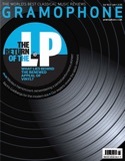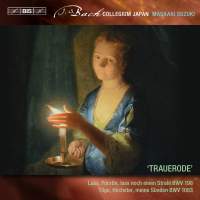Texte paru dans: / Appeared in: |
|
|
Outil de traduction (Très approximatif) |
|
|
Reviewer:
Jonathan Freeman‑Attwood It has been a while since a new account of the Trauer Ode appeared in its original form – as opposed to reconstructions for the lost music for Prince Leopold of Cöthen’s funeral and the St Mark Passion. Perhaps it is because of the work’s indeterminate place in Bach’s vocal canon that Masaaki Suzuki is recording it at the end of his cantata marathon, alongside the Lutheran Masses and other miscellany – including here the decreasingly rare Tilge, Höchster after Pergolesi’s Stabat mater.
Unlike the four ‘parody Masses’, the exquisite Trauer Ode draws on no extant material for the celebrated Funeral of the much-loved Princess of Saxony, Christianne Eberhardine – a Protestant heroine in the face of a philandering husband who accumulated Catholic territories with shameless strategic acumen. The service on October 17, 1727, is well documented and, the event being ‘political’ in both nature and personnel, Bach was keen to impress. Suzuki clearly recognises this with a ringing endorsement of Bach’s meticulous canvas of bittersweet emotions where sacred sorrow is inflected by an unusually secular view on ‘the art of dying’.
Too often the sensuality of Bach’s ‘soft’ scoring – lutes, flutes, oboes d’amore, violas da gamba, those timeless instruments of mourning – is under-projected and therefore the quest to imbue Johann Christoph Gottsched’s vivid text with real fragrance is compromised. Bach Collegium Japan produce a delectable vision in quasi-‘Passion’ clothes (the St Matthew had received its first performance only six months earlier), the choruses captivatingly detailed, luminous and with just enough galant accentuation in the framing movements to mark out the composer’s purview of prevailing taste.
Each of the soloists responds perceptively to the discrete point of their contributions. Both Joanne Lunn and Robin Blaze produce a gloriously bell-like radiance, even if, in the former’s aria, the gambas are rather earth-bound. Most of all, Suzuki delivers a captivating narrative of sadness leading seamlessly and reassuringly to idealism. This is a recording that in certain respects bucks the trend, especially in its strongly rooted reading of the wonderful tenor aria on the words ‘The sapphire house of eternity’ (often deliberately ethereal) and the slightly aloof final chorus. More nostalgia is found with Jürgen Jürgens and greater intimacy with Philippe Pierlot’s Ricercar Consort, but this recording acts as a powerful reminder of the extraordinary depths of beauty to be found in this work.
David Vickers
wrote in March about Tilge under Damien Guillon in, clearly, a highly
agreeable and refined performance (Glossa). Even if the adaptation of Psalm 51
in German requires the odd double-take from the listener, one cannot but find
solace and satisfaction in the assuaging dialogues of Carolyn Sampson and Robin
Blaze for Suzuki. As an interlude, the misattributed BWV53 is also deeply
touching and, like everything on this disc, richly coloured and treasured by
exceptional performers. |
|
|
Consultez d'autres mois / Browse other months
|
|
|
|
|
|
Cliquez l'un ou l'autre
bouton pour découvrir bien d'autres critiques de CD |
|




